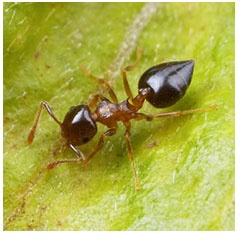
Acrobat ants may nest both outdoors and indoors. Outdoor nests are most often in dead and decaying wood such as logs, stumps, dead trees limbs, firewood and hollow tree cavities. They may nest in damp soil beneath leaf litter or rocks. The small worker ants readily enter buildings through cracks around windows and doors and other openings. Trails of workers may be seen moving between the nest and a food source. Acrobat ants feed on a variety of foods, including other insects and sweets.
When acrobat ants nest indoors they are usually inside wood or cavities kept moist with water from leaks. They may also nest in foam insulating board or sheathing. As they excavate the large galleries used as nest sites, sawdust may be deposited near the nest area.
Like all ants, the acrobat ants may produce winged, reproductive individuals (males and females) called swarmers. These sexually developed adults emerge from an established colony, usually in the fall, to disperse and start new colonies. The swarmers are harmless, but they may be the first indication of an infestation. Special treatment of swarmers beyond vacuuming or sweeping them up is not required.